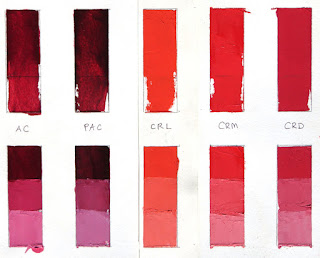 |
| Reds from Gamblin Artists Colors |
As a plein air painter, I tend to avoid bright reds—they usually have too much "punch" for the natural landscape. Instead, I tend toward the more earthy reds like Burnt Sienna and its cousins. Bright reds are rare in my world. When I'm painting in the area around my seaside studio in the Canadian Maritimes, I only find bright reds on lobster boats and lighthouses. More common are the pale pinks of the beach rose, which tend to be rather dull. (And for them, I prefer to use Quinacridone Magenta, which keeps some of its intensity when used as a tint.) Out in the Southwest, which many people think of as being filled with such bright color that the landscape seems nearly incandescent, the reds actually are still quite muted. For example, Sedona is famous for its red rocks, but they appear so vibrant only because of the juxtaposition of vegetation and its complementary greens. Pick up a rock at your feet and examine it carefully, and you'll see how dull it truly is.
On the other hand, when I'm the studio, I sometimes do push the intensity of red for effect. I might use pure Cadmium Red Medium in large swaths of sunlit rocks—and as dark as that pigment is, it really does look like it's being hit by strong sunlight. (I'll confess, I do this sometimes in the field, too; I'm not such a literalist.)
HISTORY
Red is one of the first colors early humans dug up to daub on cave walls. Early cave paintings—some 40,000 years old—were made with hematite and other earth reds. Although most earth reds are dull, another ancient pigment, cinnabar, is very intensely colored. The fact that it contains toxic mercury didn't stop alchemists in the Middle Ages from valuing it as essential in their search for the philosopher's stone.
During the 13th century, alchemists accidentally created artificial cinnabar—vermilion. Vermilion, like cinnabar, is also toxic and changes color upon exposure to the lead in lead white, another common pigment at that time. Red lead is a little better when used with lead white, but just like cinnabar and vermilion, it is toxic and prone to changing color over time when exposed to air.
These pigments were the only intense reds available until the creation of the "lake" reds such as madder in 1804. Even so, the lake reds, not actually made of pigment but of dyes fixed with a mordant, have a big problem—they are notoriously fugitive. Alizarin Crimson, another fugitive color derived from madder, was synthesized in 1868. But the problem of lightfastness wasn't truly solved until Cadmium Red was created in 1907. Soon to follow were a whole host of intense, lightfast organic (carbon-based) reds like the napthols and perylenes, which also have the advantage of being non-toxic and cheaper than cadmium colors.
USAGE
For my split-primary oil palette, I like Napthol Scarlet and Permanent Alizarin Crimson. Napthol Scarlet is warm and semi-opaque while Alizarin is cool and transparent, and together they give me a wide range of temperatures and opacity. I've played with other reds—the cadmiums, of course—and some the other organic colors. I tried Napthol Red but found it cooled down too much when added to white; Napthol Scarlet is a bit warmer and seems to hold the heat a little longer.
Lately, I've been playing with a limited earth color palette that uses just one red—Burnt Sienna— plus Yellow Ochre and Ultramarine Blue. Burnt Sienna, a dull red, makes beautiful browns and greys when used with the other two colors. In pastel, some of my favorite colors are the dull reds.
I'm including below an image of swatches I've made of colors from Gamblin. You can learn more about their line of colors here. They also have a series of informative articles about the color experience here.
Images below include draw-downs, tints and shades:
 |
| Gamblin Earth Reds: Indian Red, Burnt Sienna, Venetian Red, Transparent Earth Red |
 |
| Gamblin Mineral Reds: Alizarin Crimson, Permanent Alizarin Crimson, Cadmium Red Light, Cadmium Red Medium, Cadmium Red Deep |
 |
| Gamblin Organic Reds: Napthol Scarlet, Napthol Red, Perylene Red, Quinacridone Red, Quinacridone Magenta, Brown Pink |
Here are color swatches from Gamblin's website, showing some of the colors as tints, tones and shades. Also, if the color is transparent, there is a glaze. Tint is made with Titanium Zinc White + the color, tone is made from Portland Grey Medium + the color, and shade is made from Chromatic Black + color. The glaze swatch is made with Galkyd medium.











